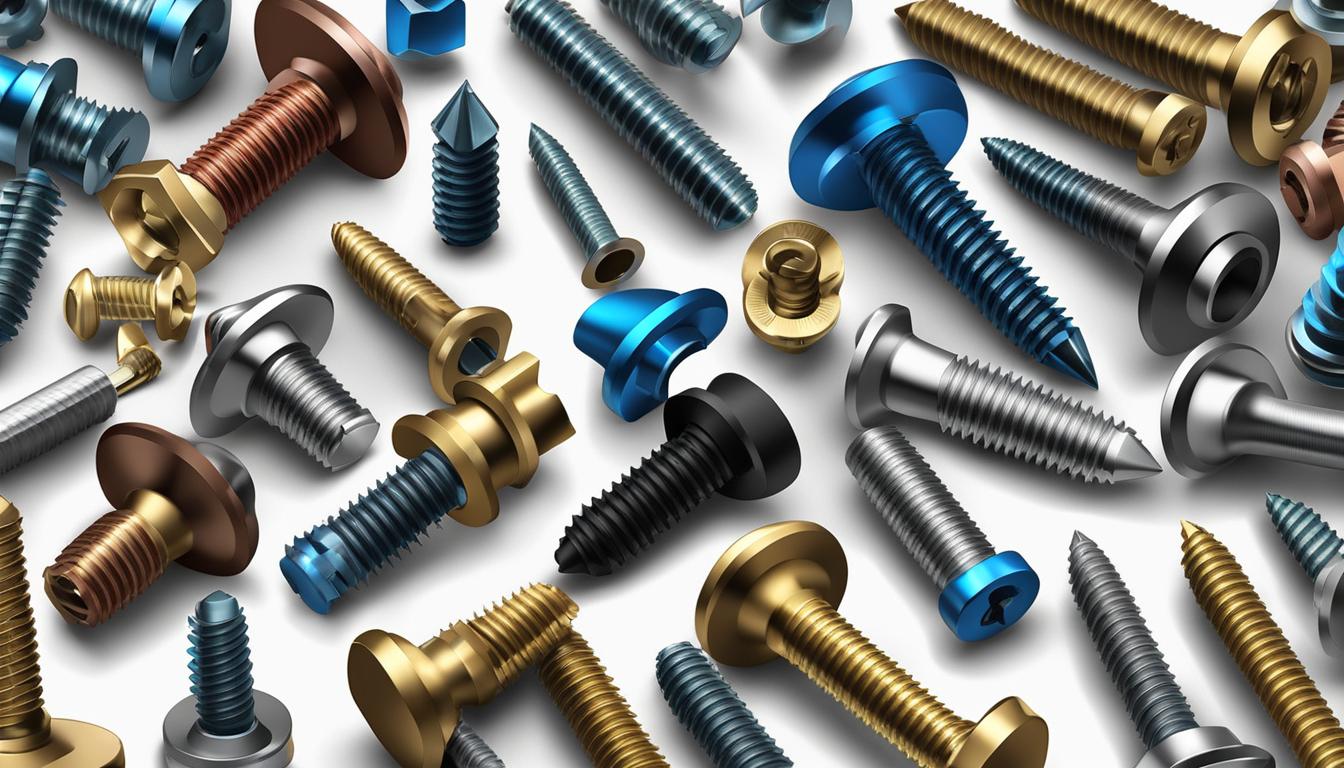This beginner’s guide covers various types of screw heads and screw drive styles to help you understand their applications. Learn about different screw head shapes and drive styles essential for any DIY project.
Why Knowing Screw Head Types Is Essential
Understanding different screw head types is crucial for anyone involved in DIY projects or professional construction. The right screw head ensures a secure fit, prevents damage, and enhances both the performance and appearance of your work.
Understanding the Importance of Proper Screw Selection
Choosing the correct screw type can make a significant difference in the success of your project. For example, flathead screws sit flush with the surface, providing a clean finish, while crosshead screws allow for greater torque and ease of use. Knowing these differences helps you select the best fastener for your specific needs.
Impact on Project Success and Durability
Using high-strength screws and those designed to prevent cam-out can significantly impact the durability of your project. Cam-out occurs when the screwdriver slips out of the screw head, potentially damaging both the screw and the material. Choosing screws that minimize this risk ensures a longer-lasting and more reliable connection.
Saving Time and Effort in DIY Projects
Selecting the right screws from the start saves time and effort. DIY enthusiasts often find that using appropriate fasteners reduces frustration and improves overall efficiency. Whether you’re assembling furniture or building a deck, knowing which screws to use can streamline your work process.
The Basics of Screw Head Types- A Beginner’s Overview
Understanding basic screw head types is essential for anyone starting with DIY or professional projects. This overview will help you get familiar with common terms and their applications.
Common Terminology and Definitions
- Flathead Screws: These have a flat top that sits flush with surfaces.
- Crosshead Screws: Also known as Phillips screws; they have an “X” shaped slot.
- Square Drive Screws: Feature a square-shaped slot for better torque transfer.
- Star Drive Screws: Known as Torx screws; they have a star-shaped slot.
How Screw Head Types Affect Functionality
Different screw heads affect how torque is transferred from the tool to the screw. For instance, six-sided hex screws are ideal for high-torque applications because they distribute force evenly across their sides, reducing wear on both the tool and fastener.
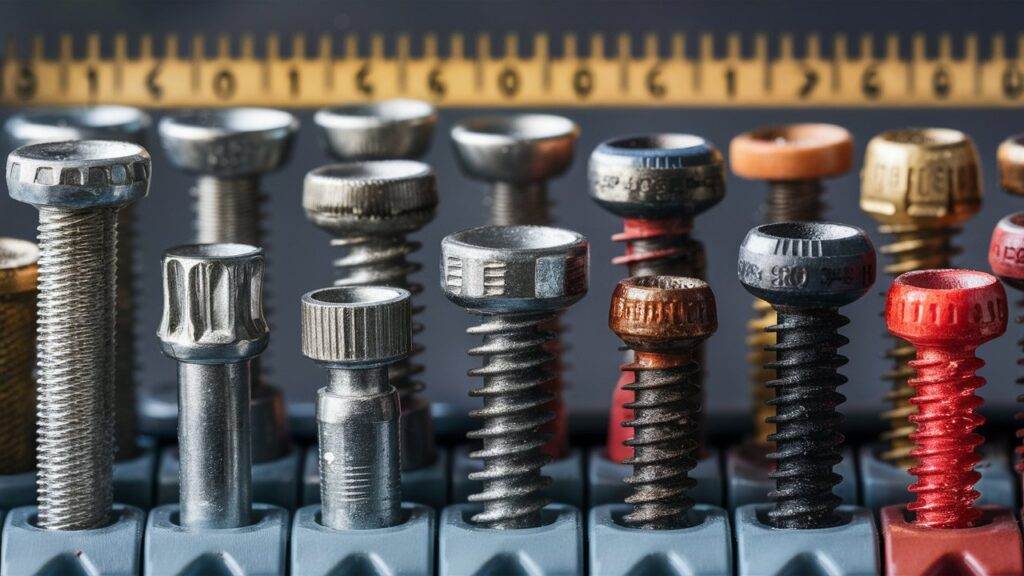
Comparison Between Various Screw Head Shapes
Here’s a quick comparison table:
| Screw Head Type | Shape | Best Use Case |
|---|---|---|
| Flat Head | Flat | Countersunk applications |
| Phillips Head | Cross | General use |
| Torx Head | Star | High-torque applications |
| Hex Head | Six-sided | Heavy-duty fastening |
| Slotted Head | Single Slot | Traditional uses |
Overview
This section provides an introduction to various screw head styles, explaining their features and typical uses.
Detailed Descriptions by Category
Each category will delve into specific types like flatheads, Phillips heads, etc., offering detailed descriptions to help you understand their unique characteristics.
Application Guidelines
Guidelines on how to choose drive styles based on your project requirements will be covered here. This includes considerations like material compatibility and environmental factors.
Tips for Selection
Quality assurance tips will help you pick durable fasteners that meet industry standards, ensuring long-lasting results in your projects.
By understanding different screw head types thoroughly, you can enhance both the quality and efficiency of your work. Make informed choices to ensure durability and achieve professional-looking results every time.
Overview of Slotted Drives
Slotted drives are one of the oldest and most common types of screw heads. They have a straight-line slot that fits flathead screwdrivers. This design is simple to use but can slip if not handled carefully.
Slot Head Screws- Traditional Yet Functional
Slot head screws, also called slotted head screws, are traditional fasteners with a single slot on top. They’re popular because they’re easy to use and widely available. But they can slip out of the screwdriver more easily than other types.
Coin-slot Screws- Usage and Variants
Coin-slot screws have a wider slot that you can turn with a coin or similar object. This makes them handy when you don’t have a screwdriver around. They come in different sizes and materials for various uses.
Hi-Torque Slot Screws: Enhanced Grip
Hi-torque slot screws provide better grip than standard slotted screws. Their design reduces the risk of slipping out (cam-out) and allows more torque without damaging the screw head.
Cruciform Drives Explained
Cruciform drives have a cross-shaped indentation on the screw head, giving better grip and torque distribution than slotted drives. Types include Phillips head, Pozidriv, Supadriv, JIS B 1012, ISO 8764, and Frearson.
Phillips Head Screws- The Common Choice
Phillips head screws are very common cruciform drives. They have a cross-shaped design that allows more torque while reducing slippage. This makes them great for DIY projects and professional tasks alike.
Differences Between Phillips and Pozidriv
Both Phillips and Pozidriv screws have cross-shaped heads, but Pozidriv has extra ribs between each arm of the cross. This gives even better torque control and reduces cam-out compared to Phillips heads.
Supadriv and JIS B 1012- Specialized Uses
Supadriv screws are like Pozidriv but offer slight improvements in grip and torque distribution. JIS B 1012 is a Japanese standard similar to Phillips but made for Japanese products specifically. Both types are used in specialized applications needing precise performance.
Square Drives and Their Applications
Square drives have a square-shaped recess in the screw head that provides excellent grip and minimizes cam-out. These include Robertson (Square) Drives and LOX-Recess variants.
Robertson (Square) Drives- Pros and Cons
Robertson (square) drives are popular in North America because they offer superior grip and ease of use. The square shape prevents slipping out of the driver bit, making them highly efficient for high-torque applications. However, they may not be as easy to find outside North America.
LOX-Recess- Advanced Application
LOX-recess screws feature an advanced design with multiple contact points within the recess for even better torque distribution than standard square drives. This makes them perfect for heavy-duty applications where maximum strength is needed.
Understanding these different screw head styles will help you choose the right one for your project needs, ensuring durability and optimal performance.

Internal Hex Drives: Versatility in Design
Internal hex drives are known for their versatility and ease of use. These screws have a hexagonal socket, making them perfect for DIY projects and professional tasks alike.
Hex Socket Screws A DIY Favorite
Hex socket screws, or Allen screws, are popular among DIY enthusiasts. They feature a hexagonal recess that fits an Allen wrench perfectly. This design offers several benefits:
- Secure Fit: The hex shape provides a firm grip, reducing the chance of slipping.
- High Torque: Allows greater torque without damaging the screw head.
- Variety of Sizes: Available in multiple sizes to fit different needs.
Double Hex Socket Screws- Added Security
Double hex socket screws offer extra security. These high-strength screws have two overlapping hex shapes, giving more grip and making them harder to tamper with. They’re often used where security is key.
Exploring Pentalobular Sockets
Pentalobular sockets have five-lobed designs that offer unique security benefits. These specialized sockets are used in industries needing tamper-resistant fasteners.
Pentalobe Screws- Unique Security Features
Pentalobe screws come with five rounded lobes, making them tamper-resistant. They are commonly found in electronics and other devices where security is crucial. Their unique shape requires special tools for installation and removal, adding extra protection against unauthorized access.
ASTER Recess- Specialized Industrial Use
The ASTER recess is another specialized design mainly used in industrial settings. It offers better torque transfer and resistance to cam-out, making it suitable for high-stress applications.
Hexalobular (Torx) Drives
Hexalobular drives, also known as Torx drives, feature a star-shaped design that provides excellent grip and torque distribution.
Standard Torx Screws- Improved Torque Transfer
Standard Torx screws have a six-point star shape that allows improved torque transfer compared to traditional screw heads. This design minimizes the risk of cam-out and ensures a secure fit.
Variants Like Torx Plus and Torx ttap
Torx Plus screws perform even better with their modified star shape offering higher torque capacity and longer tool life. The Torx ttap variant includes features like anti-wobble technology for easier installation.
Security Variations- Torx Plus Tamper-Resistant
Security variations such as Torx Plus Tamper-Resistant screws include features like center pins or unique shapes to prevent unauthorized removal. These are ideal where security is paramount.

Specialty Screw Head Types for Specific Needs
Understanding the various specialty screw head types can help you choose the right one for your specific needs. These screws are designed to offer unique benefits and accommodate different tools and applications.
Spline Socket Screws- When to Use Them
Spline socket screws are great for high-torque jobs where you need to avoid slipping. They have multiple splines that give the driver more surface area to grip. This design helps prevent stripping or slipping, making them ideal for heavy machinery and automotive work. Their high-torque capabilities ensure a strong connection, even under stress.
Combination Drives- Flexibility for Different Tools
Combination drives are super flexible because they work with different tool types. For example, a slotted/Phillips combination drive can be used with both slotted and Phillips screwdrivers. This is handy when you don’t have a specific tool on hand or need to switch tools quickly. Other examples like ACR Phillips II Plus and Recex also make it easier by fitting various driver types.
External Drives Explained
External drives come in several varieties:
- Clutch Heads: These have a bowtie shape that offers excellent torque transfer while preventing over-tightening. They’re common in automotive and appliance industries.
- Thumbscrews: Designed for easy manual tightening and loosening without tools. They’re perfect for things like computer cases or furniture that need frequent adjustments.
By knowing these external drive types, you can pick the best one for your needs.
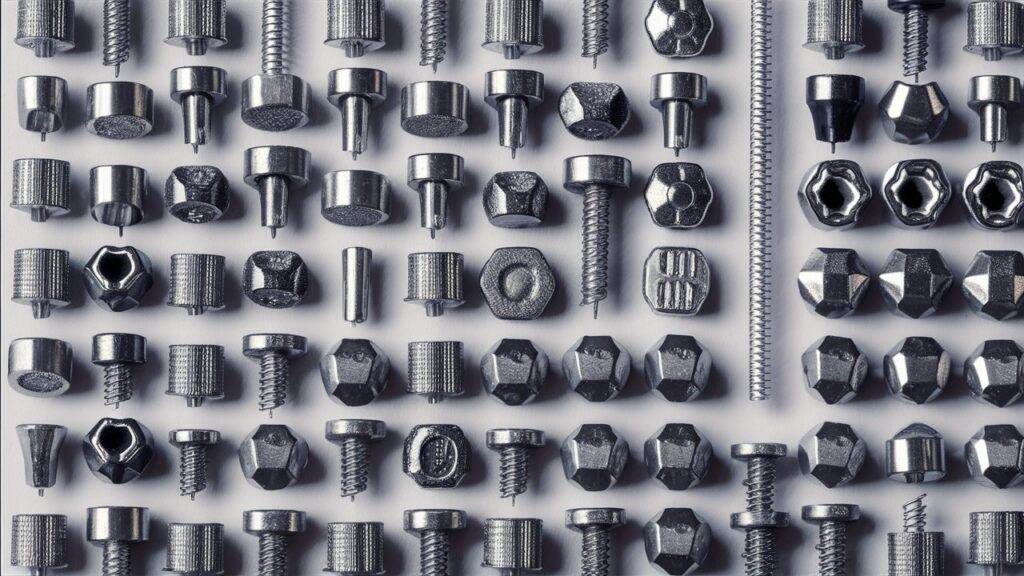
Tamper-Resistant Screw Types
Tamper-resistant screws stop unauthorized removal or tampering. They’re often used in places needing high security like public infrastructure and electronics.
One-way and Breakaway Heads
One-way head screws go in easily but can’t be removed without special tools. This makes them great for securing things in public areas where tampering could happen. Breakaway head screws snap off once installed, leaving only a smooth surface behind. These are often used in security seals to show if tampering has occurred.
Security Hex and Security Torx
Security hex screws have a hexagonal drive with a central pin that stops regular hex keys from working on them. Similarly, security Torx screws have a star-shaped drive with a central pin. Both designs make unauthorized removal hard without special tools. They’re widely used in electronics manufacturing and public installations needing high security.
Spanner and Tri-wing Designs
Spanner screws have two holes on opposite sides of the head requiring a spanner driver to engage them. This design adds security by using an uncommon drive style. Tri-wing designs feature three radial slots converging at the center; they’re often used in aerospace applications due to their strong tamper resistance properties.
Other Types of Screw Heads
Besides common screw heads like flat or Phillips heads, there are proprietary designs made for specific uses or industries.
Slotted/Torx Combination Heads
Slotted/Torx combination heads offer dual compatibility with both slotted screwdrivers and Torx drivers. This flexibility lets users choose between different driving tools based on what’s available while keeping secure fastening across various tasks like electronics assembly or furniture making.
Proprietary Heads- When Exclusivity Matters
Proprietary heads like slotted/square combinations give exclusive control over installation processes by needing specialized drivers not commonly available on the market—this ensures only authorized people can install or remove these fasteners effectively maintaining product integrity during production cycles within industries like medical device manufacturing or aerospace engineering where precision is crucial.
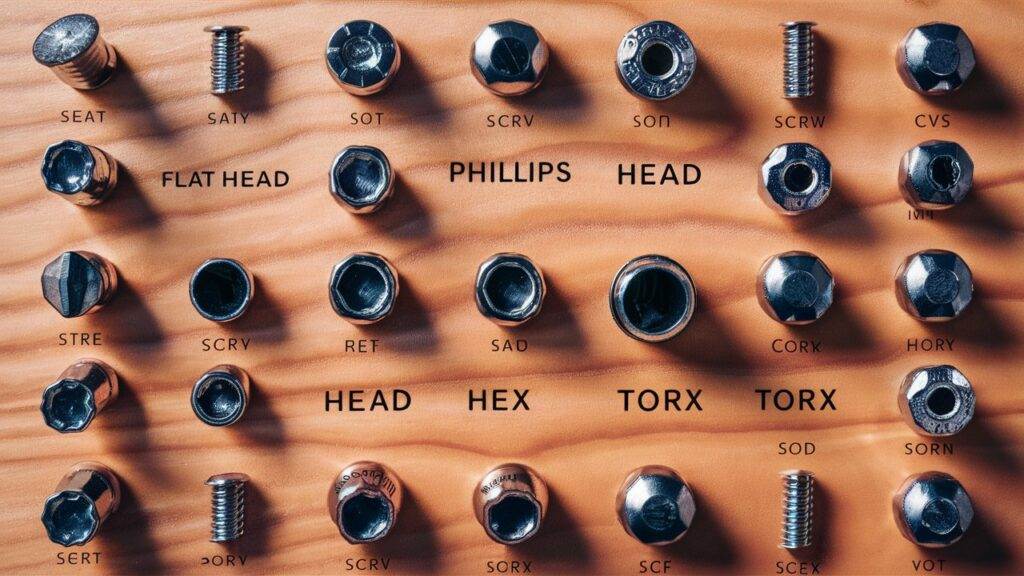
Choosing the Right Screw Head Type for Wood Projects
Flat Head Screws- Flush Finishing
Flat head screws are designed to sit flush with the surface of the material, making them ideal for wood projects that need a smooth finish. These screws have countersunk heads, which means they can be driven into the wood until they are level with or slightly below the surface. This design not only provides a clean look but also ensures that the screw does not stick out, preventing snags and creating a seamless appearance. Flat head screws are perfect for applications where both looks and functionality matter.
Oval Head Screws- Blending Aesthetics and Function
Oval head screws combine aesthetic appeal with functionality, making them a popular choice in woodworking projects where appearance is important. These screws have a slightly rounded top that sits above the surface, offering a decorative look while still providing strong holding power. The combination of their sleek design and practical use makes oval head screws suitable for furniture assembly and other visible woodwork where both strength and style are essential.
Truss Head Screws- Structural Integrity
Truss head screws offer additional holding power and structural integrity in wood projects. With their large, low-profile dome-shaped heads, these non-countersunk screws provide excellent clamping force without needing countersinking. Truss head screws are particularly useful in applications involving thinner materials or when extra support is needed to prevent pull-through. Their design ensures stability and durability, making them an excellent choice for structural woodwork.
Screw Head Types for Metal- What You Need to Know
Button Head Screws: Smooth Surface Benefits
Button head screws provide a low-profile finish ideal for metal surfaces where minimizing snagging is crucial. These screws have rounded tops that create a smooth surface once installed, reducing the risk of catching on clothing or other materials. Button head screws are often used in metalworking projects where both appearance and safety are important considerations.
Hex Head Screws- Strong and Reliable
Hex head screws are favored in metalworking due to their strength and reliability under high torque applications. Featuring six-sided heads, these screws can be easily driven using an Allen wrench or socket drive, allowing for greater torque application without damaging the screw or material. Hex head screws are commonly used in heavy-duty construction and machinery assembly where robust connections are necessary.
Pan Head Screws- Versatility Across Applications
Pan head screws offer versatility across various metalworking applications due to their wide bearing surface. Their slightly rounded heads provide excellent clamping force without requiring countersinking, making them suitable for attaching thin materials or components that need strong yet flexible fastening solutions. Pan head screws can be used in everything from electronics assembly to general metal fabrication projects.
By understanding these different screw head types and their specific benefits, you can choose the right fasteners for your projects, ensuring both durability and an aesthetically pleasing finish.
Tips for Identifying and Using Different Screw Heads
Understanding different screw head styles is crucial for DIYers and professionals. The type of screw head you choose ensures a secure fit, prevents damage, and enhances the performance and appearance of your projects.
Visual Identification Techniques
Visual identification techniques are key to recognizing different screw head shapes. Look closely at the top of the screw to determine its shape. Some common screw identification tips include:
- Flat Head: Sits flush with the surface.
- Phillips Head: Has a cross-shaped indentation.
- Torx Head: Star-shaped pattern.
- Hex Head: Six-sided recess.
Tool Compatibility and Selection
Choosing the right tool is essential for working with different drive styles and fastener types. Here are some guidelines:
- Flat Head Screws: Use a flathead screwdriver.
- Phillips Head Screws: Use a Phillips screwdriver.
- Torx Head Screws: Require a Torx driver or bit.
- Hex Head Screws: Work with an Allen wrench or hex socket.
Practical Usage Tips
Here are some practical usage tips for DIY projects and home improvement screws:
- Always use the correct tool to avoid damaging the screw or material.
- Consider the environment where you’ll use the screws—some may need to withstand moisture or temperature changes.
- Practice using different screws to become more intuitive in your selections.
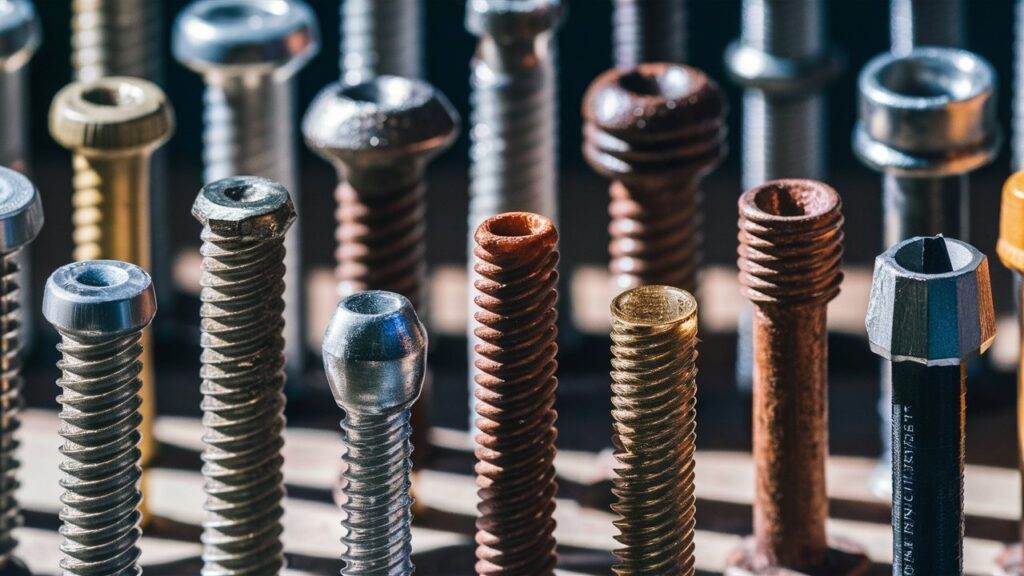
Recent Advances and Future Developments in Screw Head Designs
The world of screws is evolving with new innovations that enhance performance and usability.
Innovations in Drive Technology
Recent innovations in drive technology focus on improving cam-out resistance, which helps prevent slipping during installation. High-torque screws have been developed to handle greater force without stripping.
Material Enhancements for Better Performance
Material enhancements play a significant role in better performance. New materials make screws stronger, more durable, and resistant to corrosion, ensuring they last longer even under tough conditions.
Predicted Trends in Screw Head Evolution
Predicted trends in screw head evolution suggest we will see more specialized designs tailored for specific tasks. Expect advancements that improve ease of use, increase strength, and offer better compatibility with modern tools.
Conclusion
Understanding different screw head types is essential for successful projects. By familiarizing yourself with their benefits, you can choose the right fastener for the job, ensuring durability and appearance.

